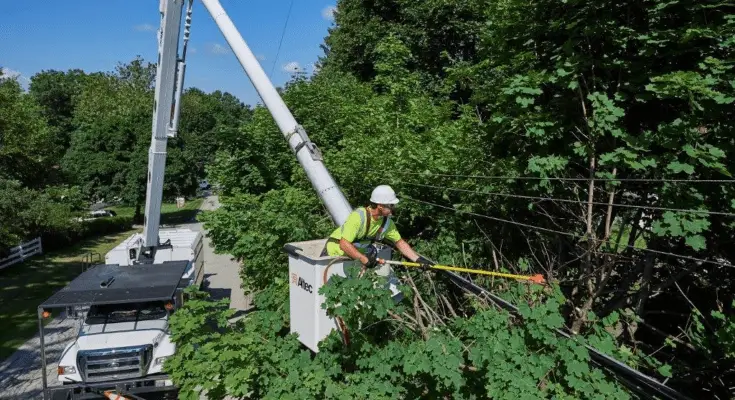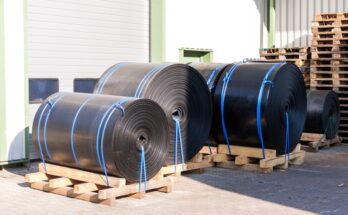Utility vegetation management (UVM) is a strategic approach essential for preventing power outages and ensuring consistent electricity delivery by managing growth around electrical infrastructure. Powerline vegetation control, pivotal for maintaining safe distances between trees and powerlines, significantly reduces fire risks and enhances uninterrupted electricity supply, addressing both safety hazards and equipment damage.
Focusing on powerline vegetation control, the article outlines challenges and technological solutions in vegetation management around powerlines. It delves into case studies of effective management, strategies for improving vegetation control, and the importance of adhering to legal clearance requirements to prevent accidents and ensure safety.
Challenges in Vegetation Management for Powerlines
Vegetation management around powerlines presents several significant challenges that impact safety and reliability in power distribution. Firstly, the sheer scale of the U.S. power grid, with approximately 5.7 million miles of power lines, complicates consistent monitoring and maintenance. This extensive network often leads to reactive rather than proactive vegetation management, increasing the risk of power outages and system failures.
Manual processes dominate the sector, from patrols for inspection to decision-making on trimming and post-work audits. This reliance on human labor is fraught with potential inefficiencies due to a shortage of skilled workers and the inherent possibility of human error. Moreover, traditional vegetation management practices, such as fixed trim cycles ranging from four to eight years, often result in redundant work and reduced system reliability.
The financial implications are also substantial, with vegetation management often being the largest line item in annual operations and maintenance budgets, sometimes exceeding $100 million for larger utilities. Despite these costs, there is a hesitation within the industry to adopt innovative technologies like remote sensing, predictive analytics, and artificial intelligence, which could significantly enhance efficiency and predictive capabilities in vegetation management. This resistance to technological adoption not only maintains high costs but also impedes improvements in safety and reliability.
Technological Solutions to Vegetation Management
In the realm of powerline vegetation control, technological advancements are revolutionizing traditional methods, enhancing efficiency, and improving safety. Key innovations include:
- Digital and AI Technologies:
- Enterprise Asset Management Solutions: Streamline operations by connecting data across workflows, reducing human error and operational costs.
- AI and Machine Learning: These technologies predict growth and risk levels to the individual tree, using historical data, species information, and environmental factors. This precision allows for targeted maintenance, optimizing resource allocation.
- Advanced Sensing and Imaging Techniques:
- LiDAR Systems: Provide detailed 3D representations of the terrain, assessing vegetation density and health through metrics like the Normalized Difference Vegetation Index (NDVI).
- Drones and Satellites: Equipped with advanced sensors, these tools offer large-scale monitoring and real-time data, crucial for proactive vegetation management.
- Integrative and Real-Time Analytics Platforms:
- Geographic Information Systems (GIS): Manage and analyze extensive data sets, visualizing impacts of weather patterns and other environmental factors on vegetation growth.
- Real-Time Data Feedback: Platforms like Fulcrum enhance decision-making by providing field teams with instant analytics, supporting swift and informed responses to emerging vegetation risks.
These technological solutions not only mitigate the risks associated with powerline vegetation but also pave the way for a future where power distribution is both safer and more reliable.
Case Studies of Effective Vegetation Management
In the realm of powerline vegetation management, case studies often illuminate the effectiveness of various strategies and technologies. One such example involves a LiDAR survey at Pound Farm in Suffolk, UK. This project aimed to identify vegetation encroaching on powerlines and unhealthy trees likely to fall and cause damage. Utilizing Routescene’s LidarViewer Pro, the team processed the data to create a detailed model and performed density analysis, which pinpointed areas where vegetation posed a risk to powerlines and identified ash trees affected by dieback disease.
Another notable initiative is the Integrated Vegetation Management (IVM) program by Co-Mo Electric Cooperative, which includes a seven-year mechanical clearing cycle. This program not only focuses on maintaining safe clearance from powerlines but also promotes ecological balance by enhancing grass and forb development, which supports small mammals and controls woody brush growth through biological means.
Lastly, the use of AAM’s LiDAR network mapping services by a transmission owner and operator showcases how high-definition data and predictive analytics can streamline maintenance processes and preemptively address potential hazards in high fire-risk areas. This approach not only ensures safety but also significantly improves efficiency in vegetation management practices.
Strategies for Improved Vegetation Control
Effective strategies for improved vegetation management around powerlines are crucial to enhancing safety and operational efficiency. Here are some targeted approaches:
- Proactive Monitoring and Regular Assessments:
- Implementing regular surveillance and detailed assessments of vegetation growth ensures early detection of potential hazards. Utility companies should utilize high spatial resolution imagery and frequent health measurements to monitor forest health and identify areas requiring immediate attention.
- Comprehensive Management Plans:
- Develop and execute detailed vegetation management plans that include:
- Scheduled Pruning and Removal: Conduct systematic pruning and removal of hazardous trees, prioritizing areas with high wildfire risks or significant fall-in events.
- Use of Prescribed Burns and Fuel Reduction: Apply controlled burns and reduce hazardous fuels to manage undergrowth and prevent fire spread.
- Stakeholder Engagement: Regularly communicate with homeowners, local communities, and regulatory bodies to ensure cooperation and address any concerns regarding vegetation management practices.
- Advanced Training and Technology Integration:
- Equip vegetation management teams with the necessary training on safe pruning techniques and the use of advanced equipment. Incorporate AI and machine learning tools to predict vegetation growth patterns and optimize maintenance schedules, reducing manual errors and operational costs.
Conclusion
Throughout this exploration of powerline vegetation control, we’ve traversed the multifaceted challenges and technological innovations shaping the landscape of utility vegetation management (UVM). From confronting the vast scale of the U.S. power grid and its maintenance challenges to leveraging cutting-edge technologies like AI, LiDAR, and drone surveillance, the journey towards enhancing safety and reliability in electricity supply is both complex and critical. The integration of digital and AI technologies, paired with proactive vegetation management strategies, signals a transformative path forward, minimizing risks and bolstering system efficiency.
The future of powerline vegetation control lies in the adoption of these innovative solutions and refined strategies, as underscored by compelling case studies and research findings. As utility companies strive to improve their operations and mitigate hazards, the emphasis on advanced technology integration and strategic management plans stands as a beacon of progress. The significance of these efforts extends beyond the immediate benefits of reduced outages and financial savings, paving the way for a safer, more sustainable interaction between nature and infrastructure. By valuing precision, proactive measures, and meaningful stakeholder engagement, the sector can indeed navigate towards a future where safety and reliability are paramount.



